Wondering which is the best option to choose for your project between MDF and plywood? Well, it doesn’t have to be a catch 22 scenario for you. You can make a rational choice if you know the pros and cons of each of these sheet materials.

MDF
MDF (Medium Density Fibreboard) is an engineered material created from softwood or hardwood waste materials that are combined with wax and bind with resin under high temperature and pressure.
Pros of MDF
- Inexpensive compared to plywood.
- It has a very smooth surface and therefore great for painting.
- The surface is very consistent, so the cut edges don’t look rugged and don’t have splinters or voids.
- Thanks to its smooth edges, you can create decorative edges using a router.
- The smoothness and consistency of MDF allow you to cut detailed designs, e.g. scalloped or scrolled designs by use of jigsaw, scroll saw or band saw.
Cons of MDF
- MDF is prone to water and other liquids. Unless it is adequately sealed, it soaks up water and swells on all edges and sides.
- Since it is very dense, MDF is heavy, and that makes it challenging to work with.
- It cannot be stained because it soaks up stains and besides, since it doesn’t have wood grain, it looks terrible when stained.
- MDF contains VOCs such as urea-formaldehyde which can affect your health. As such, one should be careful when sanding or cutting it to avoid inhaling the particles.
Plywood
Just like MDF, plywood is also an engineered sheet material created from sheets of wood veneer which are pressed together with resin to make a solid piece. It is available in different grades so you can select the right one for your home project.
Pros of Plywood.
- Engineered from a variety of wood veneer, plywood is a very strong piece.
- It is less prone to water damage, so it doesn’t soak up water as fast as MDF does.
- Since it is consist of wood grains, plywood can be stained. This property makes it ideal for tabletops, kitchen cabinets and other home projects that need large stained surfaces.
- When screwed, it holds the screws very well because the wood grains offer a grip for the screws to hold on.
Cons of Plywood
- Plywood is more costly compared to MDF, and of course, since there are different grades, the price can shoot even higher depending on the type of wood.
- Because of layers that sprout out on the edges, it requires finishing with iron-on edge banding or decorating mouldings.
- You cannot get smooth cut plywood easily like it is with MDF.
- It is harder to cut detailed designs (scalloped, scrolled, etc.) using plywood. This is because the edges will shift and there could be voids on the edges.
So Which Is an ideal Option For You?
Since MDF is vulnerable to water damage, it is ideal for indoor use such as furniture. Its smooth surface makes it a perfect option for simple interior design pieces, e.g. shelving, cabinets, etc.
Typically, plywood is preferred for flooring, doors, stairs and exterior projects. Since it bends easily, it is also ideal for creating curved surfaces. Since it is also affected by water; exterior-glued plywood is utilised outdoors but in positions where they are exposed to low moisture content.
So , an ideal option will depend on where and what you what to use each sheet material for.

